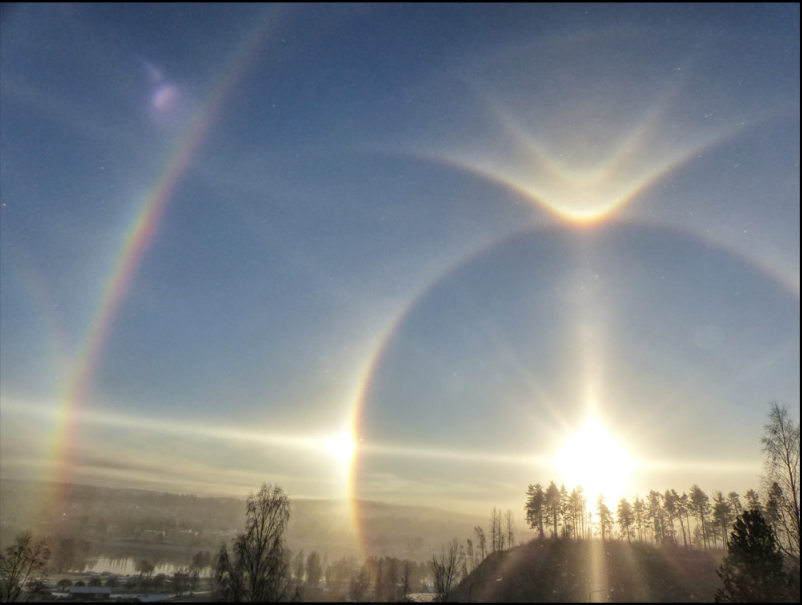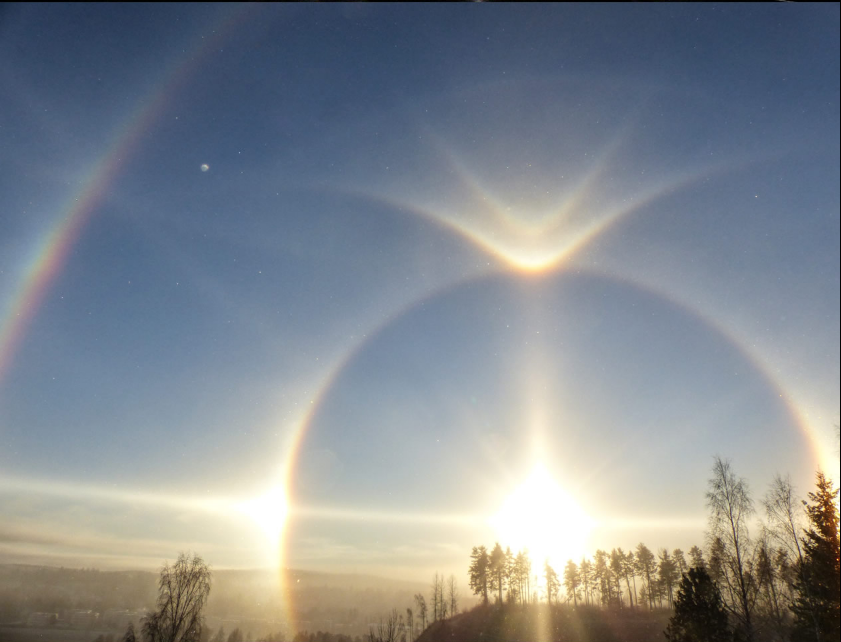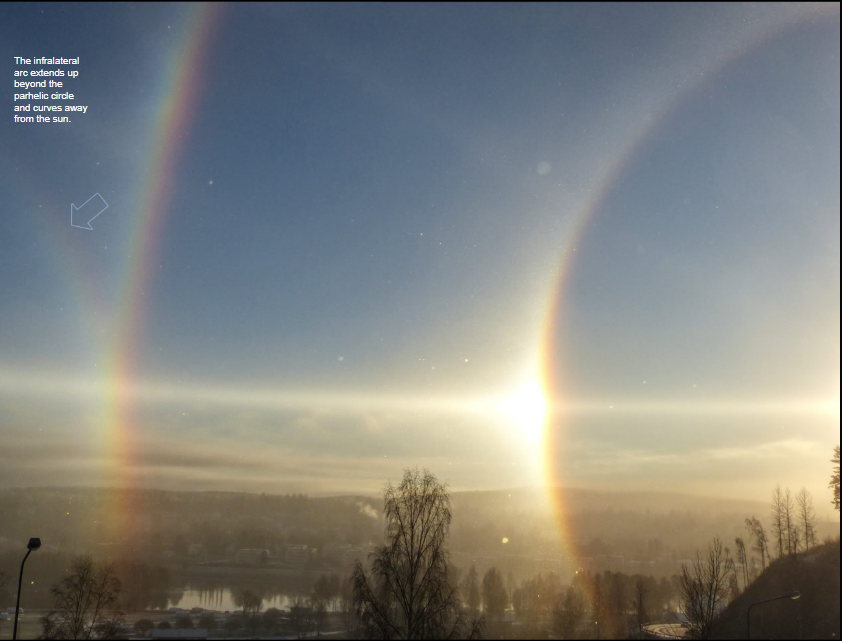Swedish Halos - OPOD
Swedish Halos - A Spectacular Atmospheric Optics Phenomenon
Have you ever witnessed a breathtaking display of ice halos in the sky? One such mesmerizing event was captured by Janne Nordin on the morning of November 23, '15, in Sollefteå, a town located in the North of Sweden. The images captured during this event showcase a remarkable array of atmospheric optics phenomena, commonly known as Swedish Halos.
The highlight of this display is the presence of multiple arcs above the sun. Alongside the familiar 22° halo encircling the low sun, a bright white parhelic circle adorned with a sundog cuts through the sky. However, it is the arcs above the sun that steal the show. A 'gull-wing' upper tangent arc can be observed, and above that, not one but two rare Parry arcs grace the sky.
The arcs on the left side of the image are known as supralateral and infralateral arcs, which intersect at the parhelic circle. These arcs exhibit vibrant colors, further enhancing the visual spectacle. While these arcs are captivating, there are even rarer atmospheric phenomena to be witnessed, as depicted in the labeled HaloSim ray tracing diagram.
To understand the formation of these mesmerizing halos, we must delve into the intricate world of ice crystals. In this particular display, four different hexagonal crystal habits and orientations played a role:
- Randomly oriented columns contributed to the formation of the 22° halo.
- Horizontal columns were responsible for the tangent, supralateral, infralateral, and Wegener arcs.
- Parry oriented columns played a crucial role in creating the Parry and helic arcs.
- Plate crystals were instrumental in producing the sundogs.
It is interesting to note that all crystal orientations, except for randomly oriented ones, contribute to the brilliance of the parhelic circle.
The presence of ski slope snow blowers in the vicinity played a significant role in this extraordinary atmospheric display. These snow blowers release tiny nuclei into the air, which then drift downwind. As these nuclei serve as a foundation, exquisite ice crystals slowly grow on them. While this may seem unnatural, it is important to highlight that these nuclei simply aid in the growth process, and the phenomenon itself is completely natural.
One particularly captivating arc in the Swedish Halos display is the infralateral arc. This arc extends beyond the parhelic circle and gracefully curves away from the sun. Its elongated form adds an extra touch of elegance to the overall spectacle.
As we marvel at the beauty of Swedish Halos, it is worth noting that this article has been automatically converted from the old website and may not appear as intended. Nevertheless, the captivating images captured by Janne Nordin and Sofia Andersson serve as a testament to the awe-inspiring atmospheric optics phenomena witnessed in Sollefteå, Sweden.
So, if you ever find yourself gazing at the sky and happen to witness such a stunning display, take a moment to appreciate the intricacies of nature and the breathtaking beauty of atmospheric optics. The world above us never ceases to amaze with its enchanting wonders.

Swedish Halos
A stunning ice halo display captured by Janne Nordin on the morning of November 23,'15 at Sollefteå in the North of Sweden.
All images ©Janne Nordin, shown with permission
A 'commonplace' 22° halo circles the low sun crossed by a bright white parhelic circle studded with a sundog.
But the show's stars are the arcs above the sun. A 'gull-wing' upper tangent arc and above that not one but two rare Parry arcs.
The strongly coloured arcs at left are supralateral and infralateral arcs crossing at the parhelic circle.
There are rarer beasts - see the labelled HaloSim ray tracing below.
The next OPOD has images by Sofia Andersson with more rare arcs.

Four hexagonal crystal habits and orientations made the display:
Random oriented columns (22. halo),
Horizontal columns (tangent, supralateral, infralateral and Wegener arcs),
Parry oriented columns (Parry and helic arcs).
Plate crystals (sundogs)
All crystals except randomly oriented ones help the parhelic circle shine.
Ski slope snow blowers were operating in the area. Tiny nuclei from these drift downwind and exquisite quality ice crystals grow slowly on them. They are quite natural - just helped a little by the extra nuclei provided.

The infralateral arc extends up beyond the parhelic circle and curves away from the sun.

Note: this article has been automatically converted from the old site and may not appear as intended. You can find the original article here.
Reference Atmospheric Optics
If you use any of the definitions, information, or data presented on Atmospheric Optics, please copy the link or reference below to properly credit us as the reference source. Thank you!
-
<a href="https://atoptics.co.uk/blog/swedish-halos-opod/">Swedish Halos - OPOD</a>
-
"Swedish Halos - OPOD". Atmospheric Optics. Accessed on April 18, 2024. https://atoptics.co.uk/blog/swedish-halos-opod/.
-
"Swedish Halos - OPOD". Atmospheric Optics, https://atoptics.co.uk/blog/swedish-halos-opod/. Accessed 18 April, 2024
-
Swedish Halos - OPOD. Atmospheric Optics. Retrieved from https://atoptics.co.uk/blog/swedish-halos-opod/.